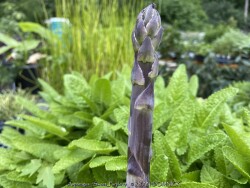



Plant Min Zone: 5b
Plant Max Zone: 9a
Sunlight: All Day Full Sun, Full Sun
Water / Rainfall: Average
Soil Quality: Average, Rich
Bloom Season: Insignificant
Flower Color: Insignificant
Berry / Fruit Color: Insignificant
Spring Foliage Color: Purple
Summer Foliage Color: Purplish Green
Fall Foliage Color: Purplish Green
Evergreen Foliage: No
Winter Interest: No
Scented Flowers: No
Drought Tolerance: Medium
Wet-Feet Tolerance: Low
Humidity Tolerance: Medium, High
Wind Tolerance: Medium
Poor Soil Tolerance: No Extreme Soils
Height: 3' - 5'
Width: 2' - 3'
Growth Rate: Slow, Medium
Service Life: Medium: 3-5 years
Maintenance Need: High
Spreading Potential: Low
Yearly Trimming Tips: Trim Perennial to Ground Around First Fall Freeze: No Winter Interest.
Plant Grouping Size: Medium Grouping of 5-10, Mass Planting of 10 or more
Best Side of House: South Exposure, West Exposure, East Exposure, North Exposure
Extreme Planting Locations: Resistant to Rabbits
Ornamental Features: Easy to Eat Edibles, Fine Texture, Exceptional / Colorful Foliage
Special Landscape Uses: None
Possible Pest Problems: Root Rot Disease
Plant Limitations: Unwanted Self-seeding, May get Occasional Winter-kill, May Needs Staking
Shippable in 2026: YES
Purple asparagus is a tall extremely fine textured plant with red fruits and edible purple stocks when emerging. This plant is a great way to incorporate edible plants into your landscape design. Best of all, asparagus is a perennial which grows a bigger crown each year with more and more delicious spears. Purple asparagus spears are quite a bit fatter than it's green counterpart. Harvest 3 to 5 times and then stop by June to allow root system to recover. Plant in rich well-drained soil in full sun with mulch. Staking may be required if maintaining an organized look to your landscape. At the end of the season, simply cut down in the fall as there is no winter interest.